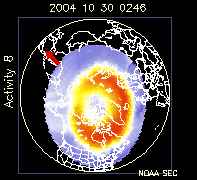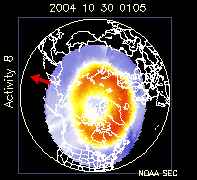|
|

|

|

|

|

|

|

|

|

|

|

|

|
The blue area surrounding the white-to-yellow-to-red oval area of these plots does not have any significance except to show the geographic extent of the data observations used to produce the plots. (The blue color does not signify greater auroral activity than the surrounding black color.) The red arrow on the plot points toward the noon meridian.
The enlarged versions of these displays of the statistical auroral oval include a presentation of the actual auroral energy input observations that were used to estimate the hemispheric power and the level of auroral activity. This presentation shows the track of the satellite over the polar region. The length of the solid line indicates that amount of energy into the atmosphere that was observed at that point along the satellite track. The scales in the four corners of the plot may be used to convert the line length to actual energy flux. The length of the dotted line is an indication of the energy of the electrons that are flowing into the atmosphere to produce the aurora. A line of two-dots represents a very low energy of about 100 eV, a length of 16 dots a high energy. Both the solid and dotted lines are plotted every 16-seconds or about 100 km along the satellite track.